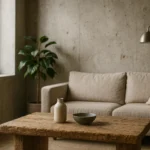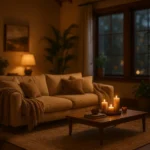Today, as I sit in my cozy living room, I’m drawn to the striking contrast between the deep charcoal walls and the crisp, white furniture. This intentional clash creates a dynamic balance that invigorates the space, giving it a modern edge. Adding contrast to a room isn’t merely about juxtaposing colors but about creating a harmonious design that evokes emotion and interest. Contrasts can transform any space from dull to dynamic, allowing your unique style to shine. Together, we’ll embark on a journey to explore simple and effective ways to add contrast to your living spaces, ensuring they feel fresh and vibrant.
Harness the Power of Black and White
The classic combination of black and white remains unparalleled in the world of interior design. When used effectively, these two contrasting colors can redefine a space, making it feel both modern and sophisticated. I love how the stark contrast can add depth and dimension, especially in small rooms where space is a premium.
1. Black Walls with White Accents: Painting one wall black might seem daring, but it can become a stunning backdrop when paired with white furniture and decor. The darkness of the black can make white pieces pop, adding a sense of drama to the room without overwhelming it.
2. White Walls with Black Furniture: For those who prefer a lighter feel, consider a white canvas complemented by black furniture. The contrast highlights the individuality of each piece, creating a clean and sophisticated look that feels inviting and spacious.
To capture the full potential of this duo, play with varying textures and finishes. A glossy black floor with matte white walls, for instance, can add nuance and interest, creating a room that’s both elegant and comforting.
Infuse Color with Intentional Contrasts
While black and white are timeless, adding colored accents can inject personality and vibrancy into a room. By using color theory strategically, one can create eye-catching contrasts that offer visual interest without overshadowing the room’s primary aesthetic.
1. Bold Color Accents: Consider using bold colors like teal, mustard, or cherry red against neutral backdrops. These shades create a dynamic contrast that draws the eye and adds energy to the space. For a cohesive look, repeat the color in small doses throughout the room—think a teal vase paired with teal throw pillows.
2. Complementary Color Pairings: Utilize the color wheel to discover complementary colors that, when paired, create natural contrasts. For instance, a room with blue walls can be contrasted with orange decor, offering a lively yet balanced aesthetic that feels modern and fresh.
Don’t shy away from mixing patterns and textures. A striped rug against a solid color wall can enhance the contrast further, enriching the room’s visual appeal.
Play with Light and Shadow
Lighting is a powerful tool in design, capable of adding dramatic contrasts that can change the entire feel of a room. By strategically using light and shadow, one can create spaces that are not only illuminated but also deeply engaging.
1. Layered Lighting: Incorporate multiple layers of lighting to add depth and interest. Use a combination of overhead lights, floor lamps, and task lighting to create varied levels of illumination, casting intriguing shadows that add dimension to the room.
2. Highlighting Architectural Features: Use accent lighting to draw attention to architectural features like a fireplace mantle or an exposed brick wall. The contrast between the light and shadow enhances the texture and adds a touch of elegance.
Don’t forget the power of natural light. Allow sunlight to flood through the windows during the day, revealing the room’s true colors and enhancing any existing contrasts. At night, use dimmers to soften lighting, creating warm, inviting spaces that feel cozy and personal.
Contrasting Textures for Dynamic Interiors
While color and light are crucial, texture is often the unsung hero of contrast in interior design. Mixing textures can create tactile interest and deepen a room’s character, offering a richer, more layered aesthetic that captures the eye.
1. Mixing Materials: Combine materials like leather, wood, glass, and metal. A leather sofa against a wooden coffee table creates a contrast not only in color but in feel. The juxtaposition of these materials can add a modern touch to a traditional space.
2. Textured Accessories: Introduce tactile decor elements like velvet cushions, woven throws, and shaggy rugs. These items can add warmth and comfort, breaking up the visual monotony and inviting you to experience the space in new ways.
Remember that it’s not just about creating contrast for contrast’s sake. Instead, focus on balancing different elements so that they complement rather than clash. This harmony will ensure that your space feels cohesive and well thought out.
Create Contrast with Scale and Proportion
Contrasts in scale and proportion can be just as impactful as those in color and texture. Playing with the size of furniture and decor can control the flow of a room and highlight key areas, offering unique visual interest.
1. Oversized Pieces in Small Spaces: Don’t hesitate to introduce an oversized chair or art piece in a small room. The boldness of large items can make a space feel luxurious and inviting, providing a focal point that draws the eye.
2. Mixing Large and Small Items: Balance is essential. Pairing a grand sofa with a petite coffee table creates a satisfying visual contrast that adds intrigue to a space. Likewise, hanging large artwork above a small console table can make both items stand out, enhancing the room’s overall aesthetic.
Navigating the art of contrast in interior design is about more than just visual appeal—it’s about creating spaces that resonate on a deeper level. By thoughtfully combining elements of color, light, texture, and scale, anyone can design rooms that are not only beautiful but also impactful.
As we wrap up, it’s clear that adding contrast to a room isn’t just about bold colors or daring patterns. It’s about carefully orchestrating elements to create a harmonious balance that resonates with you. Whether it’s the timeless appeal of black and white, the vibrant energy of bold colors, or the nuanced interplay of light and shadow, contrasts breathe life into our spaces.
Our homes are reflections of who we are, and by embracing contrasts, we ensure that every room tells a story. A story of elegance and warmth, of modernity and tradition, of comfort and style. So go ahead, take a chance with contrast, and watch as your living space transforms into a haven that feels both inviting and inspiring.
FAQ
How can I introduce contrast using color in a room?
One of the simplest methods to add contrast is by incorporating complementary colors. For instance, pairing blues with oranges or yellows with purples can create a vibrant contrast. Consider using one color for the walls and the opposite on furniture or decor items.
What role do textures play in enhancing room contrast?
Textures can significantly enhance contrast by providing depth and interest. Mixing different textures, like a smooth leather sofa with a fluffy wool throw or a sleek metal lamp on a rustic wooden table, can create a dynamic visual effect.
Can I use patterns to increase contrast in a room?
Absolutely. Patterns can add a striking contrast when used thoughtfully. Consider adding patterned cushions, rugs, or wallpaper to break the monotony of solid colors and create visual intrigue.
Are there simple ways to create contrast with lighting?
Yes, lighting can dramatically change the ambiance and introduce contrast. Using a combination of ambient, task, and accent lighting can highlight different areas and textures within a room, creating a layered, contrasting effect.
How can I achieve contrast through furnishings without a complete redesign?
You can easily introduce contrast by mixing different furniture styles or finishes. For example, pairing a modern chair with a vintage table or a glossy cabinet with a matte bookshelf can create an eclectic and contrasted look without the need for an entire redesign.



